Pharmacology: Angiotensin II and Cardiovascular Health
VerifiedAdded on 2020/03/04
|8
|1240
|42
Report
AI Summary
This pharmacology report explores the complex relationship between Angiotensin II, ACE inhibitors, and cardiovascular health. The report begins by examining the role of Elastase-2 in regulating circulatory sympathovagal balance, highlighting the findings from both in-vivo and ex-vivo studies, including the use of knockout mice to assess cardiac function. It then delves into the impact of increased Angiotensin II concentrations on the development of atherosclerotic lesions, supported by research on hyperlipidemia and the activation of monocytes and macrophages. Finally, the report discusses the clinical applications of Angiotensin Converting Enzyme (ACE) inhibitors in managing cardiovascular conditions, including their effects on ventricular hypertrophy, arterial damage, and the balance within the sympathovagal system. The referenced articles provide a comparative analysis of Angiotensin's impact on cardiovascular health, challenging the use of ACE inhibitors in cardiovascular disease treatment.
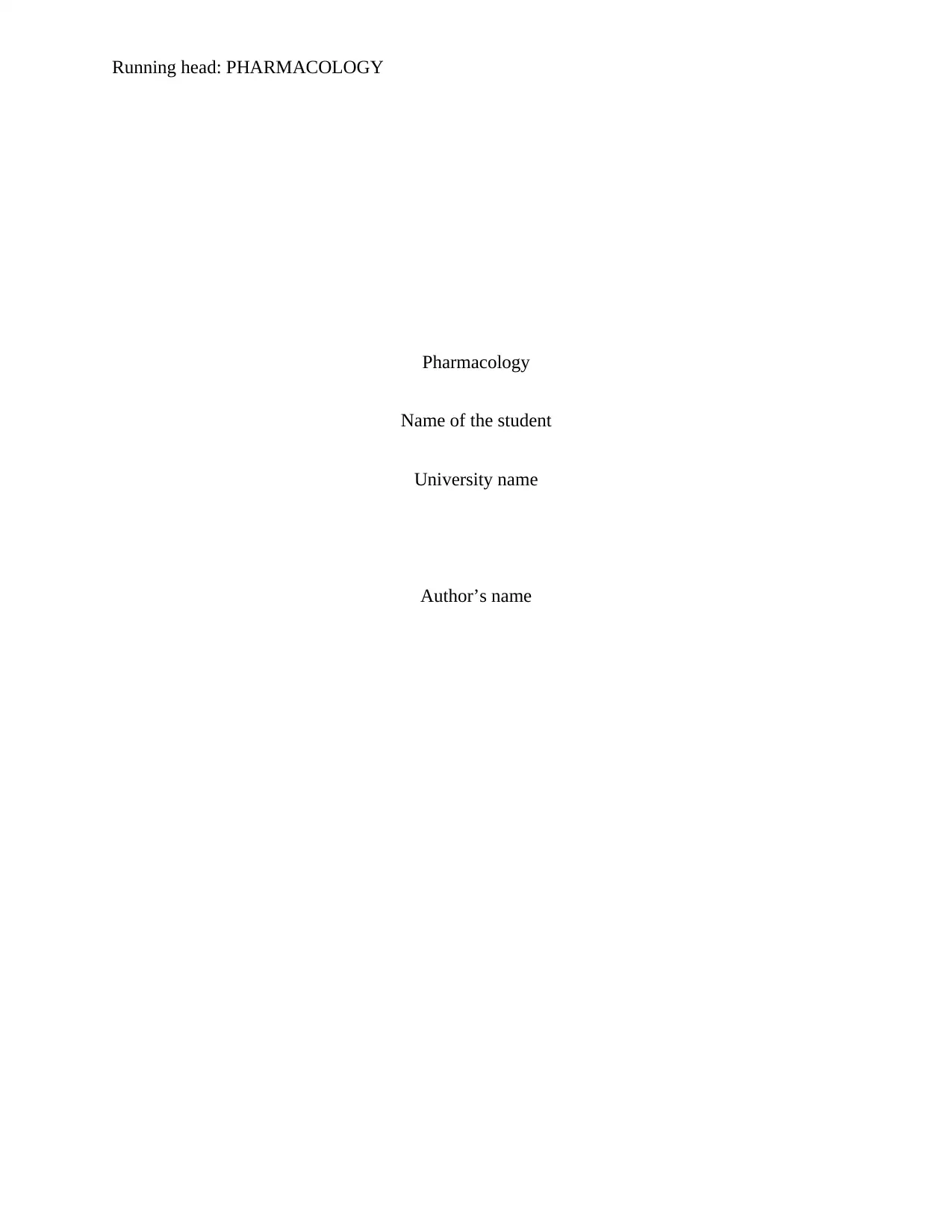
Running head: PHARMACOLOGY
Pharmacology
Name of the student
University name
Author’s name
Pharmacology
Name of the student
University name
Author’s name
Paraphrase This Document
Need a fresh take? Get an instant paraphrase of this document with our AI Paraphraser
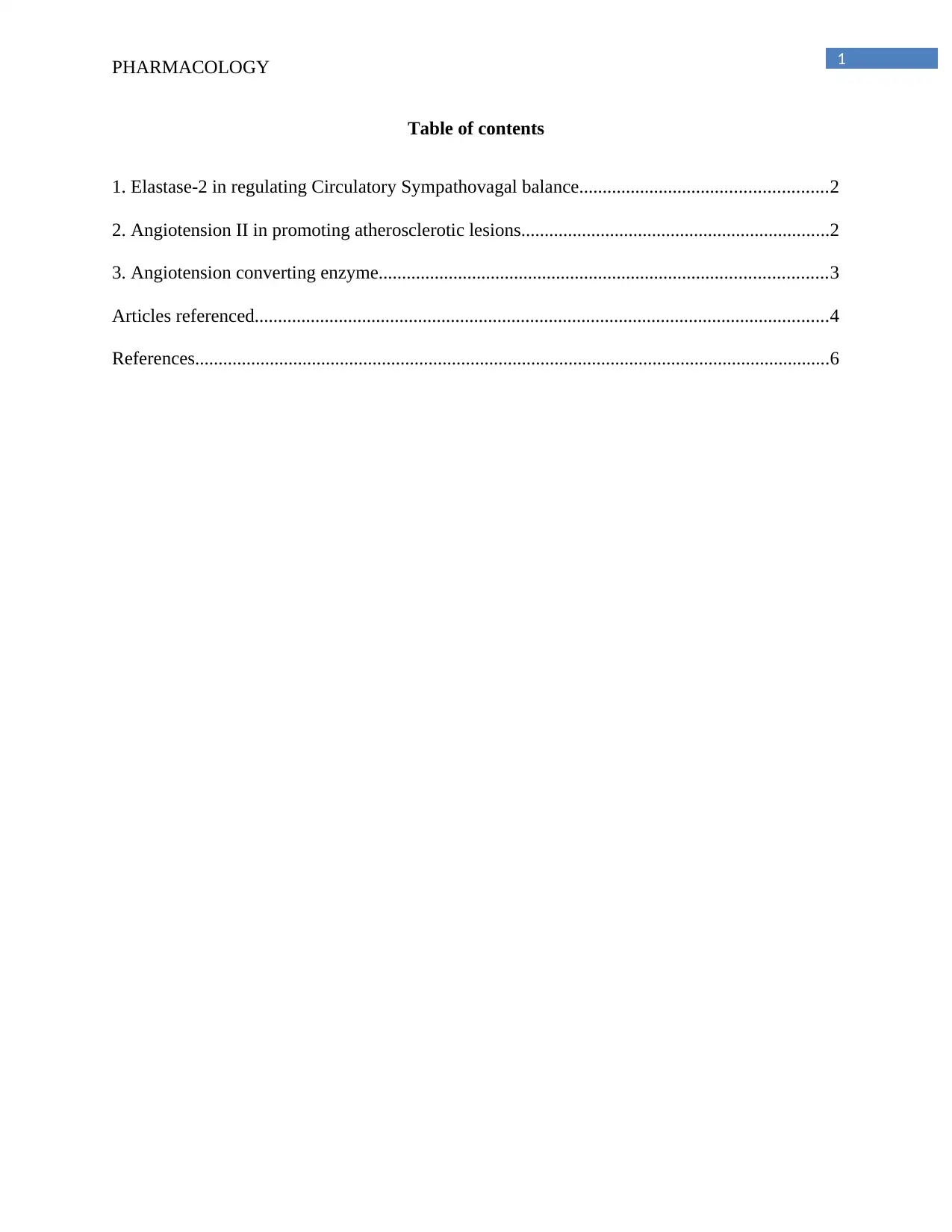
1PHARMACOLOGY
Table of contents
1. Elastase-2 in regulating Circulatory Sympathovagal balance.....................................................2
2. Angiotension II in promoting atherosclerotic lesions..................................................................2
3. Angiotension converting enzyme................................................................................................3
Articles referenced...........................................................................................................................4
References........................................................................................................................................6
Table of contents
1. Elastase-2 in regulating Circulatory Sympathovagal balance.....................................................2
2. Angiotension II in promoting atherosclerotic lesions..................................................................2
3. Angiotension converting enzyme................................................................................................3
Articles referenced...........................................................................................................................4
References........................................................................................................................................6
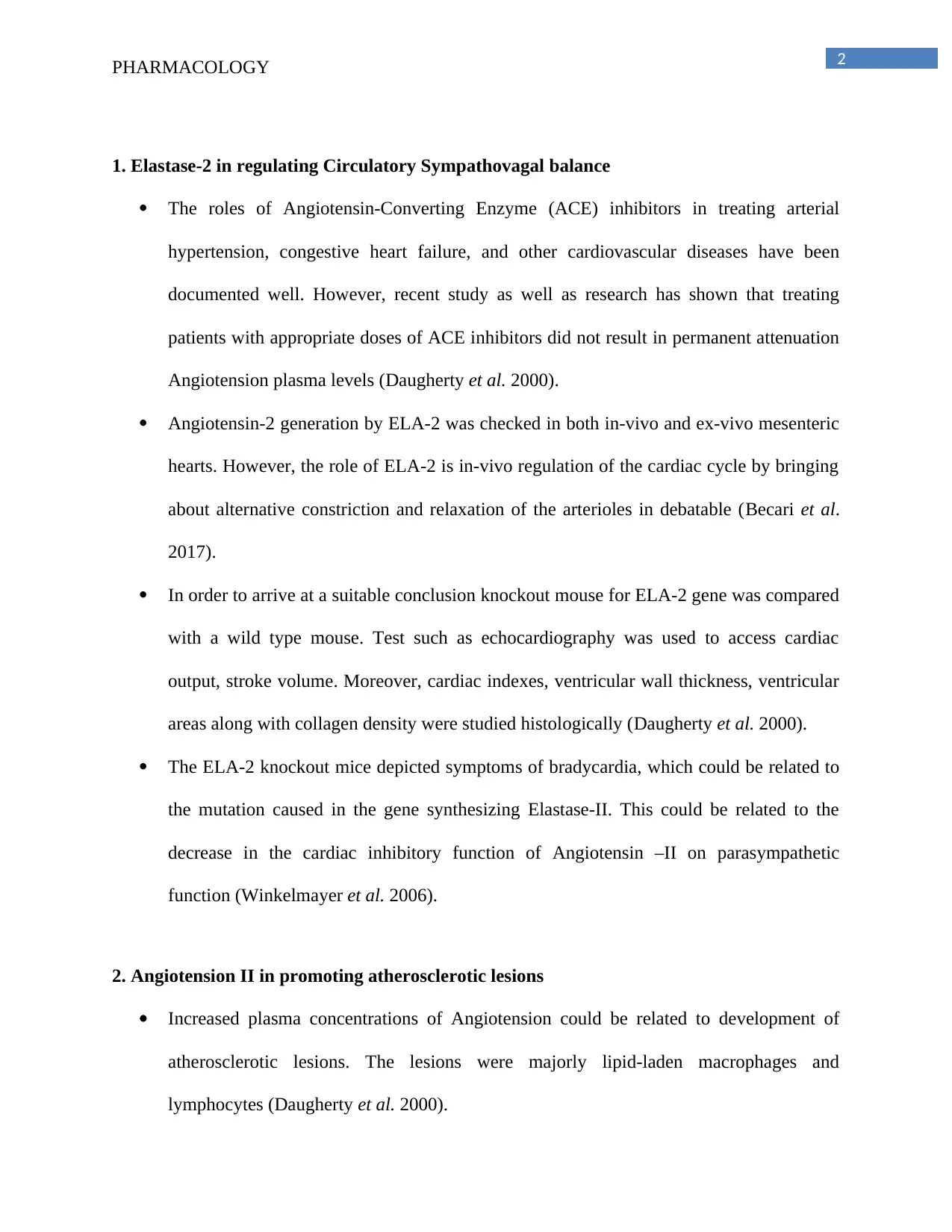
2PHARMACOLOGY
1. Elastase-2 in regulating Circulatory Sympathovagal balance
The roles of Angiotensin-Converting Enzyme (ACE) inhibitors in treating arterial
hypertension, congestive heart failure, and other cardiovascular diseases have been
documented well. However, recent study as well as research has shown that treating
patients with appropriate doses of ACE inhibitors did not result in permanent attenuation
Angiotension plasma levels (Daugherty et al. 2000).
Angiotensin-2 generation by ELA-2 was checked in both in-vivo and ex-vivo mesenteric
hearts. However, the role of ELA-2 is in-vivo regulation of the cardiac cycle by bringing
about alternative constriction and relaxation of the arterioles in debatable (Becari et al.
2017).
In order to arrive at a suitable conclusion knockout mouse for ELA-2 gene was compared
with a wild type mouse. Test such as echocardiography was used to access cardiac
output, stroke volume. Moreover, cardiac indexes, ventricular wall thickness, ventricular
areas along with collagen density were studied histologically (Daugherty et al. 2000).
The ELA-2 knockout mice depicted symptoms of bradycardia, which could be related to
the mutation caused in the gene synthesizing Elastase-II. This could be related to the
decrease in the cardiac inhibitory function of Angiotensin –II on parasympathetic
function (Winkelmayer et al. 2006).
2. Angiotension II in promoting atherosclerotic lesions
Increased plasma concentrations of Angiotension could be related to development of
atherosclerotic lesions. The lesions were majorly lipid-laden macrophages and
lymphocytes (Daugherty et al. 2000).
1. Elastase-2 in regulating Circulatory Sympathovagal balance
The roles of Angiotensin-Converting Enzyme (ACE) inhibitors in treating arterial
hypertension, congestive heart failure, and other cardiovascular diseases have been
documented well. However, recent study as well as research has shown that treating
patients with appropriate doses of ACE inhibitors did not result in permanent attenuation
Angiotension plasma levels (Daugherty et al. 2000).
Angiotensin-2 generation by ELA-2 was checked in both in-vivo and ex-vivo mesenteric
hearts. However, the role of ELA-2 is in-vivo regulation of the cardiac cycle by bringing
about alternative constriction and relaxation of the arterioles in debatable (Becari et al.
2017).
In order to arrive at a suitable conclusion knockout mouse for ELA-2 gene was compared
with a wild type mouse. Test such as echocardiography was used to access cardiac
output, stroke volume. Moreover, cardiac indexes, ventricular wall thickness, ventricular
areas along with collagen density were studied histologically (Daugherty et al. 2000).
The ELA-2 knockout mice depicted symptoms of bradycardia, which could be related to
the mutation caused in the gene synthesizing Elastase-II. This could be related to the
decrease in the cardiac inhibitory function of Angiotensin –II on parasympathetic
function (Winkelmayer et al. 2006).
2. Angiotension II in promoting atherosclerotic lesions
Increased plasma concentrations of Angiotension could be related to development of
atherosclerotic lesions. The lesions were majorly lipid-laden macrophages and
lymphocytes (Daugherty et al. 2000).
⊘ This is a preview!⊘
Do you want full access?
Subscribe today to unlock all pages.

Trusted by 1+ million students worldwide
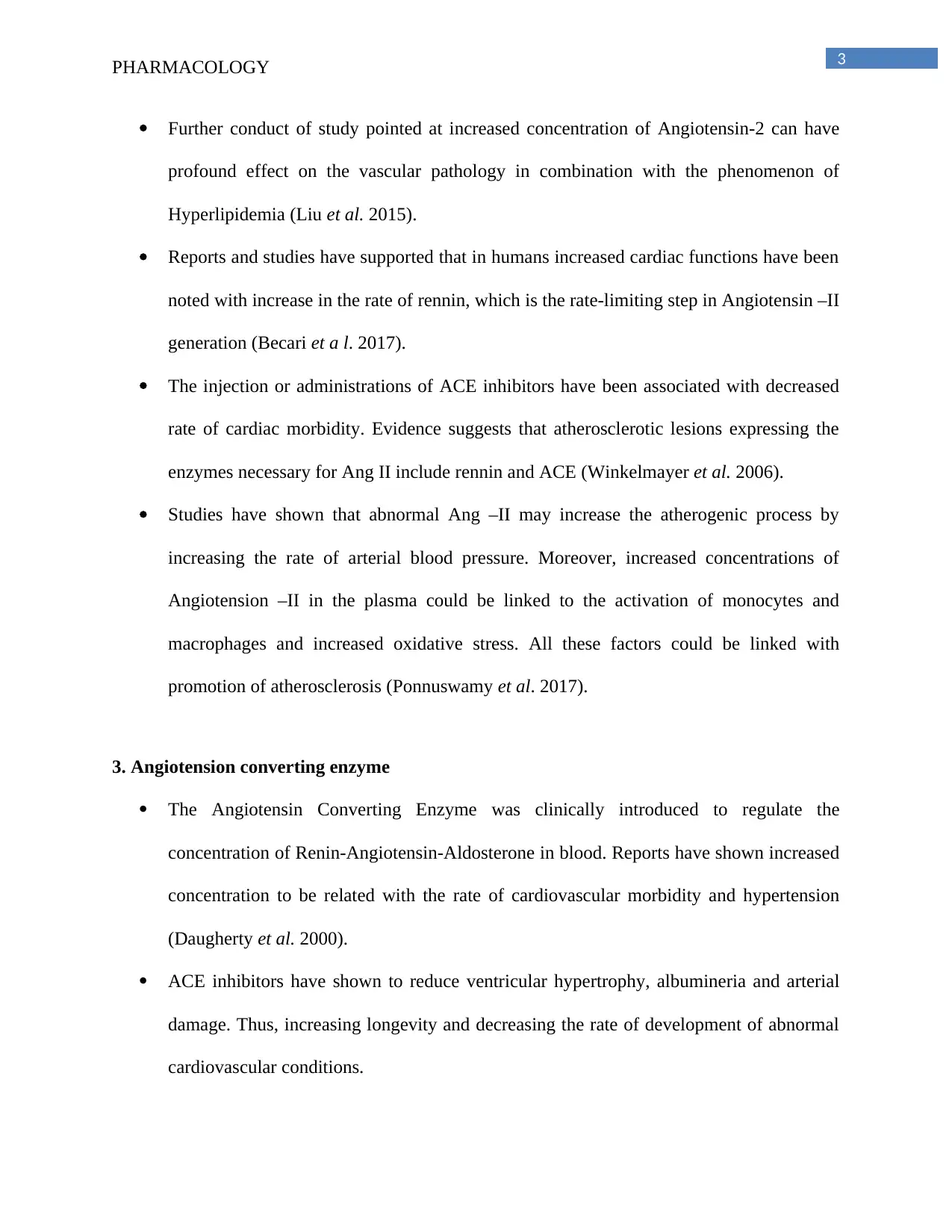
3PHARMACOLOGY
Further conduct of study pointed at increased concentration of Angiotensin-2 can have
profound effect on the vascular pathology in combination with the phenomenon of
Hyperlipidemia (Liu et al. 2015).
Reports and studies have supported that in humans increased cardiac functions have been
noted with increase in the rate of rennin, which is the rate-limiting step in Angiotensin –II
generation (Becari et a l. 2017).
The injection or administrations of ACE inhibitors have been associated with decreased
rate of cardiac morbidity. Evidence suggests that atherosclerotic lesions expressing the
enzymes necessary for Ang II include rennin and ACE (Winkelmayer et al. 2006).
Studies have shown that abnormal Ang –II may increase the atherogenic process by
increasing the rate of arterial blood pressure. Moreover, increased concentrations of
Angiotension –II in the plasma could be linked to the activation of monocytes and
macrophages and increased oxidative stress. All these factors could be linked with
promotion of atherosclerosis (Ponnuswamy et al. 2017).
3. Angiotension converting enzyme
The Angiotensin Converting Enzyme was clinically introduced to regulate the
concentration of Renin-Angiotensin-Aldosterone in blood. Reports have shown increased
concentration to be related with the rate of cardiovascular morbidity and hypertension
(Daugherty et al. 2000).
ACE inhibitors have shown to reduce ventricular hypertrophy, albumineria and arterial
damage. Thus, increasing longevity and decreasing the rate of development of abnormal
cardiovascular conditions.
Further conduct of study pointed at increased concentration of Angiotensin-2 can have
profound effect on the vascular pathology in combination with the phenomenon of
Hyperlipidemia (Liu et al. 2015).
Reports and studies have supported that in humans increased cardiac functions have been
noted with increase in the rate of rennin, which is the rate-limiting step in Angiotensin –II
generation (Becari et a l. 2017).
The injection or administrations of ACE inhibitors have been associated with decreased
rate of cardiac morbidity. Evidence suggests that atherosclerotic lesions expressing the
enzymes necessary for Ang II include rennin and ACE (Winkelmayer et al. 2006).
Studies have shown that abnormal Ang –II may increase the atherogenic process by
increasing the rate of arterial blood pressure. Moreover, increased concentrations of
Angiotension –II in the plasma could be linked to the activation of monocytes and
macrophages and increased oxidative stress. All these factors could be linked with
promotion of atherosclerosis (Ponnuswamy et al. 2017).
3. Angiotension converting enzyme
The Angiotensin Converting Enzyme was clinically introduced to regulate the
concentration of Renin-Angiotensin-Aldosterone in blood. Reports have shown increased
concentration to be related with the rate of cardiovascular morbidity and hypertension
(Daugherty et al. 2000).
ACE inhibitors have shown to reduce ventricular hypertrophy, albumineria and arterial
damage. Thus, increasing longevity and decreasing the rate of development of abnormal
cardiovascular conditions.
Paraphrase This Document
Need a fresh take? Get an instant paraphrase of this document with our AI Paraphraser
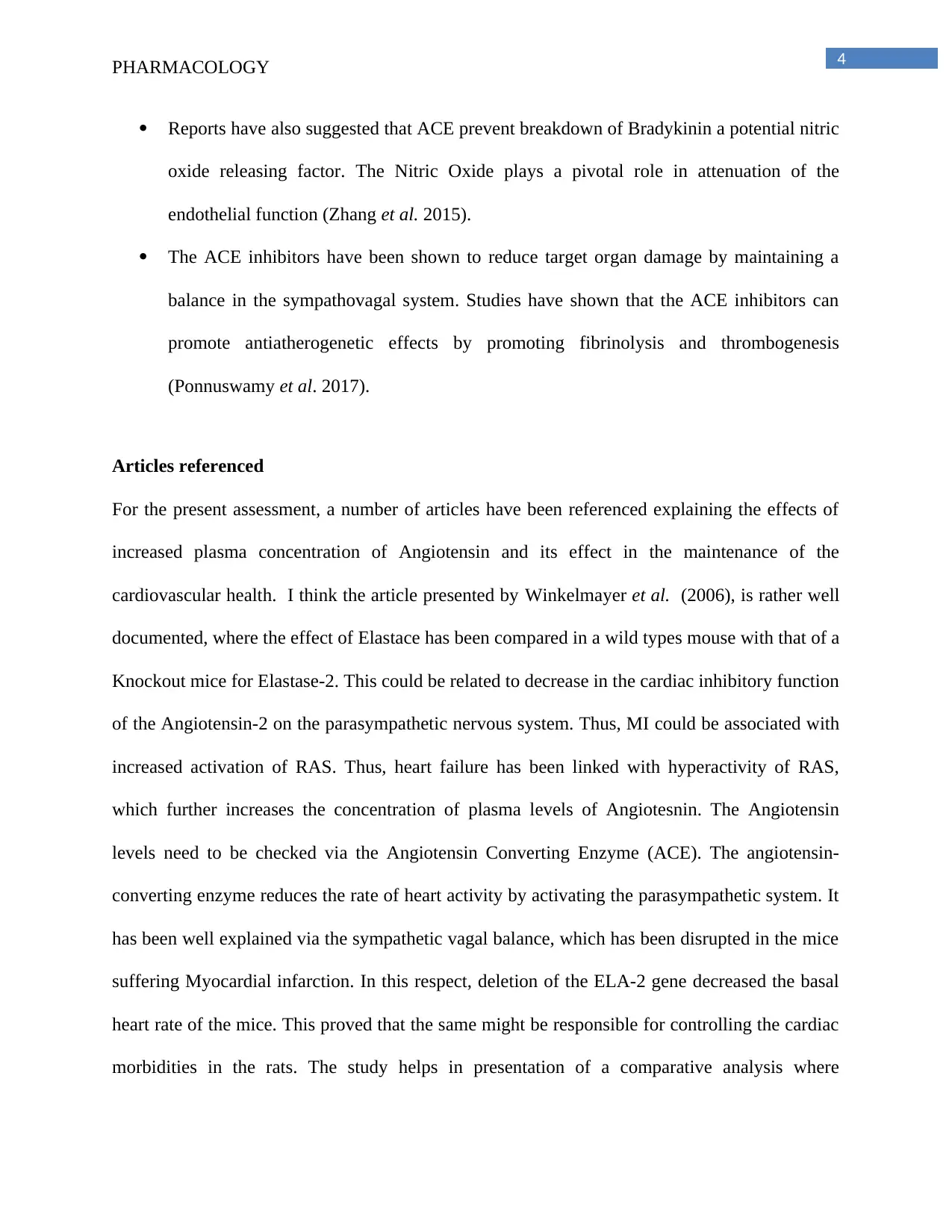
4PHARMACOLOGY
Reports have also suggested that ACE prevent breakdown of Bradykinin a potential nitric
oxide releasing factor. The Nitric Oxide plays a pivotal role in attenuation of the
endothelial function (Zhang et al. 2015).
The ACE inhibitors have been shown to reduce target organ damage by maintaining a
balance in the sympathovagal system. Studies have shown that the ACE inhibitors can
promote antiatherogenetic effects by promoting fibrinolysis and thrombogenesis
(Ponnuswamy et al. 2017).
Articles referenced
For the present assessment, a number of articles have been referenced explaining the effects of
increased plasma concentration of Angiotensin and its effect in the maintenance of the
cardiovascular health. I think the article presented by Winkelmayer et al. (2006), is rather well
documented, where the effect of Elastace has been compared in a wild types mouse with that of a
Knockout mice for Elastase-2. This could be related to decrease in the cardiac inhibitory function
of the Angiotensin-2 on the parasympathetic nervous system. Thus, MI could be associated with
increased activation of RAS. Thus, heart failure has been linked with hyperactivity of RAS,
which further increases the concentration of plasma levels of Angiotesnin. The Angiotensin
levels need to be checked via the Angiotensin Converting Enzyme (ACE). The angiotensin-
converting enzyme reduces the rate of heart activity by activating the parasympathetic system. It
has been well explained via the sympathetic vagal balance, which has been disrupted in the mice
suffering Myocardial infarction. In this respect, deletion of the ELA-2 gene decreased the basal
heart rate of the mice. This proved that the same might be responsible for controlling the cardiac
morbidities in the rats. The study helps in presentation of a comparative analysis where
Reports have also suggested that ACE prevent breakdown of Bradykinin a potential nitric
oxide releasing factor. The Nitric Oxide plays a pivotal role in attenuation of the
endothelial function (Zhang et al. 2015).
The ACE inhibitors have been shown to reduce target organ damage by maintaining a
balance in the sympathovagal system. Studies have shown that the ACE inhibitors can
promote antiatherogenetic effects by promoting fibrinolysis and thrombogenesis
(Ponnuswamy et al. 2017).
Articles referenced
For the present assessment, a number of articles have been referenced explaining the effects of
increased plasma concentration of Angiotensin and its effect in the maintenance of the
cardiovascular health. I think the article presented by Winkelmayer et al. (2006), is rather well
documented, where the effect of Elastace has been compared in a wild types mouse with that of a
Knockout mice for Elastase-2. This could be related to decrease in the cardiac inhibitory function
of the Angiotensin-2 on the parasympathetic nervous system. Thus, MI could be associated with
increased activation of RAS. Thus, heart failure has been linked with hyperactivity of RAS,
which further increases the concentration of plasma levels of Angiotesnin. The Angiotensin
levels need to be checked via the Angiotensin Converting Enzyme (ACE). The angiotensin-
converting enzyme reduces the rate of heart activity by activating the parasympathetic system. It
has been well explained via the sympathetic vagal balance, which has been disrupted in the mice
suffering Myocardial infarction. In this respect, deletion of the ELA-2 gene decreased the basal
heart rate of the mice. This proved that the same might be responsible for controlling the cardiac
morbidities in the rats. The study helps in presentation of a comparative analysis where

5PHARMACOLOGY
hyperactive concentration of Angiotensin have been seen to promote the rate of atherogenesis.
This presents a debatable area where the use of ACE in the treatment of cardiovascular disease
has been challenged.
hyperactive concentration of Angiotensin have been seen to promote the rate of atherogenesis.
This presents a debatable area where the use of ACE in the treatment of cardiovascular disease
has been challenged.
⊘ This is a preview!⊘
Do you want full access?
Subscribe today to unlock all pages.

Trusted by 1+ million students worldwide
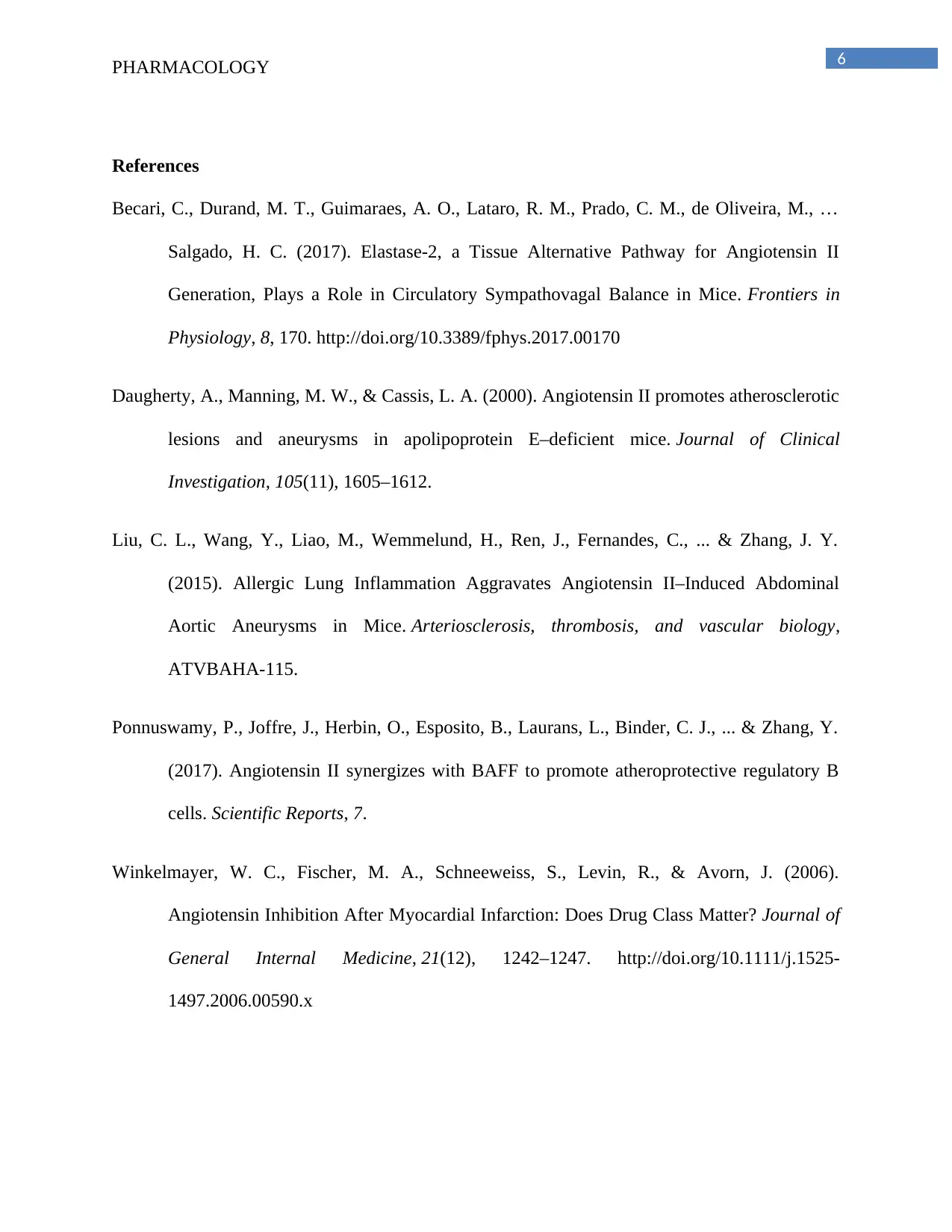
6PHARMACOLOGY
References
Becari, C., Durand, M. T., Guimaraes, A. O., Lataro, R. M., Prado, C. M., de Oliveira, M., …
Salgado, H. C. (2017). Elastase-2, a Tissue Alternative Pathway for Angiotensin II
Generation, Plays a Role in Circulatory Sympathovagal Balance in Mice. Frontiers in
Physiology, 8, 170. http://doi.org/10.3389/fphys.2017.00170
Daugherty, A., Manning, M. W., & Cassis, L. A. (2000). Angiotensin II promotes atherosclerotic
lesions and aneurysms in apolipoprotein E–deficient mice. Journal of Clinical
Investigation, 105(11), 1605–1612.
Liu, C. L., Wang, Y., Liao, M., Wemmelund, H., Ren, J., Fernandes, C., ... & Zhang, J. Y.
(2015). Allergic Lung Inflammation Aggravates Angiotensin II–Induced Abdominal
Aortic Aneurysms in Mice. Arteriosclerosis, thrombosis, and vascular biology,
ATVBAHA-115.
Ponnuswamy, P., Joffre, J., Herbin, O., Esposito, B., Laurans, L., Binder, C. J., ... & Zhang, Y.
(2017). Angiotensin II synergizes with BAFF to promote atheroprotective regulatory B
cells. Scientific Reports, 7.
Winkelmayer, W. C., Fischer, M. A., Schneeweiss, S., Levin, R., & Avorn, J. (2006).
Angiotensin Inhibition After Myocardial Infarction: Does Drug Class Matter? Journal of
General Internal Medicine, 21(12), 1242–1247. http://doi.org/10.1111/j.1525-
1497.2006.00590.x
References
Becari, C., Durand, M. T., Guimaraes, A. O., Lataro, R. M., Prado, C. M., de Oliveira, M., …
Salgado, H. C. (2017). Elastase-2, a Tissue Alternative Pathway for Angiotensin II
Generation, Plays a Role in Circulatory Sympathovagal Balance in Mice. Frontiers in
Physiology, 8, 170. http://doi.org/10.3389/fphys.2017.00170
Daugherty, A., Manning, M. W., & Cassis, L. A. (2000). Angiotensin II promotes atherosclerotic
lesions and aneurysms in apolipoprotein E–deficient mice. Journal of Clinical
Investigation, 105(11), 1605–1612.
Liu, C. L., Wang, Y., Liao, M., Wemmelund, H., Ren, J., Fernandes, C., ... & Zhang, J. Y.
(2015). Allergic Lung Inflammation Aggravates Angiotensin II–Induced Abdominal
Aortic Aneurysms in Mice. Arteriosclerosis, thrombosis, and vascular biology,
ATVBAHA-115.
Ponnuswamy, P., Joffre, J., Herbin, O., Esposito, B., Laurans, L., Binder, C. J., ... & Zhang, Y.
(2017). Angiotensin II synergizes with BAFF to promote atheroprotective regulatory B
cells. Scientific Reports, 7.
Winkelmayer, W. C., Fischer, M. A., Schneeweiss, S., Levin, R., & Avorn, J. (2006).
Angiotensin Inhibition After Myocardial Infarction: Does Drug Class Matter? Journal of
General Internal Medicine, 21(12), 1242–1247. http://doi.org/10.1111/j.1525-
1497.2006.00590.x
Paraphrase This Document
Need a fresh take? Get an instant paraphrase of this document with our AI Paraphraser

7PHARMACOLOGY
Zhang, X., Thatcher, S., Wu, C., Daugherty, A., & Cassis, L. A. (2015). Castration of male mice
prevents the progression of established angiotensin II-induced abdominal aortic
aneurysms. Journal of vascular surgery, 61(3), 767-776.
Zhang, X., Thatcher, S., Wu, C., Daugherty, A., & Cassis, L. A. (2015). Castration of male mice
prevents the progression of established angiotensin II-induced abdominal aortic
aneurysms. Journal of vascular surgery, 61(3), 767-776.
1 out of 8
Related Documents
Your All-in-One AI-Powered Toolkit for Academic Success.
+13062052269
info@desklib.com
Available 24*7 on WhatsApp / Email
![[object Object]](/_next/static/media/star-bottom.7253800d.svg)
Unlock your academic potential
Copyright © 2020–2025 A2Z Services. All Rights Reserved. Developed and managed by ZUCOL.





